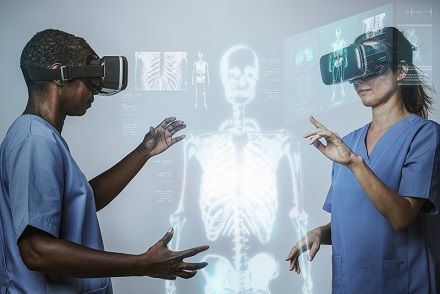Augmented Reality (AR) has emerged as a powerful tool in various industries, and its integration in medical training games is revolutionizing the way healthcare professionals acquire and enhance their skills. This exciting technology combines virtual elements with the real world, providing immersive experiences that simulate real-world scenarios for medical training. As a result, AR medical training games are rapidly gaining popularity, offering an innovative and engaging approach to enhance medical education and practice.
Enhancing Immersion and Realism
Traditional medical training methods often rely on textbooks and conventional simulation models, which may lack the depth of realism necessary for healthcare professionals to develop their skills adequately. However, AR technology bridges this gap by overlaying virtual objects onto the real environment in real-time. This integration provides medical trainees with a highly realistic and immersive learning environment, enabling them to interact with virtual patients, medical equipment, and procedures as if they were real.
With AR medical training games, learners can practice complex procedures, such as surgeries, in a controlled and safe environment. They can visualize and manipulate virtual organs, tissues, and surgical instruments, closely mimicking real-life scenarios. By manipulating these virtual elements, medical professionals can develop their motor skills, spatial understanding, and critical decision-making abilities, all while minimizing the risks and costs associated with traditional training methods.
Increasing Accessibility and Flexibility
One significant advantage of integrating AR into medical training games is increased accessibility and flexibility. With traditional training methods, medical professionals often need to be physically present in specific locations or rely on expensive simulation centers. However, AR technology allows medical training to occur anywhere and at any time, as long as users have access to a compatible device, such as a smartphone or tablet.
Medical trainees can delve into immersive learning experiences without the need for expensive specialized equipment, making training more readily available and cost-effective. This flexibility also enables healthcare institutions to offer personalized training programs tailored to meet the individual needs of medical professionals at various stages of their careers. AR medical training games have the potential to enhance medical education and continuous professional development significantly.
Improving Collaboration and Communication
Collaboration and effective communication are vital aspects of healthcare, especially in team-based medical environments. AR medical training games facilitate better collaboration among healthcare professionals by allowing them to interact with virtual patients and participate in multi-user experiences. By simulating real-world scenarios, these games enable users to work together, make collective decisions, and communicate effectively to provide better patient care.
In addition, AR medical training games can connect medical professionals across different geographical locations, further enhancing global collaboration and knowledge sharing. Such games enable doctors to collaborate on simulated medical cases, discuss treatment strategies, and exchange expertise in real-time using AR interfaces. This interconnectedness fosters a learning community that promotes continuous improvement in medical practice and patient outcomes.
Challenges and Future Perspectives
While the integration of AR in medical training games offers tremendous possibilities, some challenges need to be addressed for its widespread adoption. One significant challenge is the development and validation of accurate virtual models and simulations that closely resemble real medical scenarios. The accuracy and realism of these virtual models are crucial to ensure the effectiveness and reliability of medical training using AR.
Another challenge lies in the availability and affordability of AR devices. As the technology advances and becomes more affordable, widespread adoption can be expected. Additionally, continuous research is required to establish evidence-based practices and standards for using AR in medical training, ensuring that it is integrated seamlessly into existing curricula.
Looking ahead, the integration of augmented reality in medical training games holds immense potential for transforming medical education and practice. As technology continues to evolve, AR will enable healthcare professionals to gain new skills, refine existing ones, and deliver improved patient care. It will revolutionize the way healthcare professionals are trained, providing them with engaging, realistic, and accessible learning experiences that lead to better healthcare outcomes for all.
